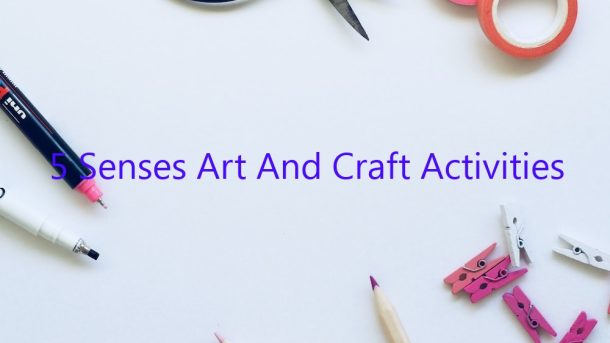One of the great things about being a kid is that your senses are constantly firing on all cylinders. Everything is new and exciting, and the possibilities for exploration seem endless. While adults may lose some of the sense of wonderment as they age, kids never stop exploring the world around them through their five senses.
One way to help kids connect with their senses is through art and craft activities. These activities allow kids to use their hands and their imaginations to create something that they can see, feel, smell, taste, and hear. Here are five easy art and craft activities that will help kids connect with their senses:
1. Touch: Sensory Play Dough
Kids love playing with dough, and sensory play dough is a great way to connect with tactile sensations. You can make your own sensory play dough by mixing flour, salt, and water together. Then, add in any other ingredients that you want to include, such as food coloring, glitter, or essential oils.
2. Smell: Homemade Playdough
Playdough is a classic kids’ activity, and you can add a sense of smell to it by making your own homemade version. All you need is flour, salt, oil, and water. Simply mix all the ingredients together and cook it over low heat until it forms a dough. Add in your favorite essential oils for a fun smell.
3. Sight: Rainbow Salt Painting
This activity is a fun way to explore color and light. You’ll need white paper, salt, food coloring, and a light source. Start by mixing the food coloring into the salt until the salt is fully colored. Then, place the salt on the white paper and use a light source to watch the colors change.
4. Taste: Edible Finger Paint
Kids love painting, and edible finger paint is a fun way to add a taste element to the activity. You can make your own edible finger paint by mixing cornstarch, water, food coloring, and sugar together. Add in any other flavors that you want to include, such as lemon or vanilla.
5. Sound: Homemade Instruments
Kids love making noise, and homemade instruments are a great way to do it. You can make simple instruments out of household objects, such as a drum made out of a pot and a spoon, or a xylophone made out of wooden blocks.
Contents
What activities use all five senses?
You may be surprised to learn that many activities use all five of our senses. From eating to playing sports, here are some examples of activities that engage all of our senses:
Tasting food: When we eat, we use our sense of taste to enjoy different flavors. Our tongues have different taste receptors that allow us to taste sweet, sour, salty, and bitter flavors.
Smelling food: We also use our sense of smell when we eat. Our noses have special receptors that allow us to smell different aromas. This is why food often smells better than it tastes.
seeing food: We use our sense of sight when we look at food. We can tell what different foods look like and whether they are ripe or rotten.
Touching food: We use our sense of touch when we eat. Our tongues and mouths feel the texture of food as we chew it.
Hearing food: We use our sense of hearing when we eat. We can hear the crunch of food as we chew it and the sound of someone eating a crunchy snack.
What are the five senses in art?
What are the five senses in art?
There are five main senses that are used in art: sight, sound, smell, taste, and touch. Each sense can be used to create a different experience for the viewer.
Sight is the most commonly used sense in art. It can be used to create illusions, to show perspective, and to create moods. Sight can be used to show the beauty of the world and to make a statement about the artist’s feelings about the world.
Sound can be used to create moods, to set the scene, and to create reactions in the viewer. It can also be used to create a sense of space.
Smell can be used to create moods and to set the scene. It can also be used to create a sense of place.
Taste can be used to create moods, to set the scene, and to create reactions in the viewer.
Touch can be used to create moods, to set the scene, and to create reactions in the viewer. It can also be used to create a sense of place.
What are some activities which stimulate the 5 senses in toddlers?
The five senses are the foundation of early childhood development. Stimulating these senses can help toddlers learn, grow and explore the world around them.
Touch is one of the most important senses for toddlers. They learn best through touch, so providing them with opportunities to touch different textures is important. Some ideas include giving them a soft blanket to feel, letting them play with sand and water or letting them explore different fruits and vegetables.
Sight is another important sense for toddlers. They learn about the world around them by looking at it. Giving them opportunities to look at different colors, shapes and sizes is important. You can do this by putting different objects in front of them and letting them explore, taking them on walks or showing them pictures.
Hearing is also a key sense for toddlers. They learn about the world around them by hearing different sounds. You can help stimulate their hearing by talking to them, reading to them, playing music or letting them explore different sounds.
Smell and taste are also important for toddlers. They learn about the world around them by smelling different smells and tasting different flavors. You can help stimulate their sense of smell by letting them smell different flowers or spices, and you can help stimulate their sense of taste by letting them taste different fruits and vegetables.
All of these activities can help stimulate the five senses in toddlers, which will help them learn and grow.
What are the activities of craft?
Craft is a form of creative expression that typically involves making things by hand. There are many different types of craft, and people can be creative in a variety of ways when they engage in this activity. Some common crafts include knitting, crochet, quilting, needlepoint, and scrapbooking.
People often engage in craft activities as a way to relax and de-stress. The repetitive motions involved in many crafts can be soothing, and the end result can be a tangible reminder of your accomplishments. Crafting can also be a social activity, and it can be a lot of fun to work on projects with friends.
There are many different ways to get involved in craft. You can take classes at a local craft store, or you can watch online tutorials to learn new techniques. There are also many online communities where people can share their craft projects.
Craft can be a fun, relaxing way to spend your time, and it can also be a great way to express your creativity. If you’re looking for a new hobby, consider giving craft a try.
What can you smell activity?
What can you smell activity?
Some people enjoy the smell of a good book, others the smell of a fresh baked pie. What about the smell of a new car? Or the smell of the rain? Everyone smells different things and enjoys different smells.
What we smell is determined by what is in the air and what our noses are sensitive to. There are many things that we can smell, but what we smell depends on what we are looking for. Some smells are obvious, like the smell of a skunk, while others are more subtle, like the smell of a rose.
We can smell things that are around us, like the smell of food cooking, or we can smell things that are far away, like the smell of a campfire. We can also smell things that are inside of us, like the smell of our own skin.
Some smells are pleasant, like the smell of a rose, and others are not, like the smell of a skunk. Whether a smell is pleasant or not depends on what we are used to smelling. Some people like the smell of skunks, while other people do not.
We smell with our noses. Our noses have special cells called olfactory cells. These cells are very sensitive and can detect very small amounts of smell. When the air goes into our noses, the olfactory cells detect the smell and send a signal to our brains. Our brains then tell us what we are smelling.
Some smells are so strong that they can make us feel sick. The smell of ammonia, for example, can make some people feel sick. The smell of a skunk can also make some people feel sick.
Smells are also used to help us remember things. The smell of a rose, for example, might remind us of a time we went to a rose garden. The smell of a campfire might remind us of a time we went camping.
Some smells are dangerous, like the smell of a gas leak. If you smell something that smells like gas, you should always leave the area and call the police.
Smells are a very important part of our lives. We use smells to help us remember things, to tell us what is happening around us, and to make us feel happy or sad. Smells are a very important part of who we are.
How do you introduce your five senses?
Introducing your five senses is a great way for kids to learn more about their bodies. Each of our five senses — sight, sound, smell, taste, and touch — play an important role in our everyday lives.
Sight is our ability to see the world around us. Our eyes allow us to see colors and shapes, and to read and write.
Sound is our ability to hear the world around us. Our ears allow us to hear sounds, from the faintest whistle to the loudest thunder.
Smell is our ability to smell the world around us. Our noses allow us to smell flowers, food, and other things in the environment.
Taste is our ability to taste the world around us. Our tongues allow us to taste sweet, sour, salty, and bitter foods.
Touch is our ability to feel the world around us. Our skin allows us to feel the texture of objects, and to feel warmth and cold.
Why is sensory art important?
Sensory art is an important part of a child’s development. It helps them to explore and learn about their world through their senses.
Sensory art can include activities such as painting, drawing, sculpting, and crafting. It can also involve using different textures, materials, and smells.
Sensory art is a great way for children to learn about their feelings and emotions. It can help them to express themselves, and to understand and deal with their feelings.
Sensory art can also help children to learn about colours, shapes, and sizes. It can help them to develop their creativity and imagination.
Sensory art is a fun and enjoyable way for children to learn about themselves and the world around them.




